Z77 mITX Round-Up: Five of the Best – MSI, Zotac, ASRock, EVGA and ASUS
by Ian Cutress on December 31, 2012 7:00 AM EST- Posted in
- Motherboards
- MSI
- ASRock
- EVGA
- ZOTAC
- Asus
- Ivy Bridge
- Z77
- mITX
ASRock Z77E-ITX BIOS
As already mentioned in the overview to the Z77E-ITX, its BIOS is a step back from the most recent implementations of the BIOS we have seen on the X79 Extreme11 and FM2A85X Extreme6 – instead of that starry background we get the older blue on white indicative of the earlier Z77 products. This is mostly likely due to the mid-2012 release of this motherboard, but going through the history of the ASRock BIOS, there is an evolution taking place:
ASRock H67M-GE/HT
ASRock Z77E-ITX
ASRock X79 Extreme11
Despite the evolution, ASRock have kept the general design constant. This means information like the motherboard model, BIOS version, processor installed, processor speed, memory installed and memory speed are right there on the front menu – useful for anyone wanting this information without loading an OS or opening up the case. All that is missing is perhaps the CPU temperature and CPU fan speeds. If this was all wrapped up in an aesthetic and interactive scenario we would be on to a winner.
With the Z77E-ITX BIOS, the Main screen has access to two functions – the System Browser and the Online Management Guard.
The System Browser shows the motherboard with all the changeable ports highlighted. By rolling the mouse over each of them, it will tell the user what it detects in that port. Thus if a SATA device suddenly stops working, users can check this to make sure the BIOS still recognizes it.
The Online Management Guard is an interesting way to get around the ‘how to keep the kids off the internet when they should be doing schoolwork’ issue – users can select hours of the day at which the network controller will be disabled. Unfortunately the system is easily disabled by going back into the BIOS and either changing the BIOS clock or changing the OMG setup itself. Yes, OMG is an odd name for this feature – “OMG, it’s so easy to disable!”
The main bulk of the options are found in the OC Tweaker menu:
The OC Tweaker menu is arranged into lists of features relating to separate parts of the system. First is the CPU configuration, relating to CPU ratio, BCLK and power limitations. We also have overclocking support for the integrated graphics. Underneath this is the DRAM timing options, which give XMP support or a manual adjustment of the timing ratios. The voltages are further down, and we are given Load Line Calibration options as well with diagrams to show how LLC varies with ‘Level’. Finally there are options to save the current settings for future usage.
The Advanced menu deals with the non-overclocking options: we have access to our SATA/USB configurations, as well as the extra controllers on board and the NB/SB options. In order to flash the BIOS via USB or the Internet, the options are in this menu.
The fan settings are found in the H/W Monitor option along the top, and in keeping with previous ASRock motherboards, the fans are set to 100% by default. This is by no means the best way of presenting the motherboard out of the box, resulting in high noise levels unless the options are changed. The fan options on the Z77E-ITX allow for both fans to have a ‘maximum’ temperature after which the fans are on full, and a target fan speed which sets the fans to that speed below the target temperature.
Elsewhere in the BIOS are boot options and security options. Annoyingly missing is a boot override function, useful for those one-off USB installation scenarios.


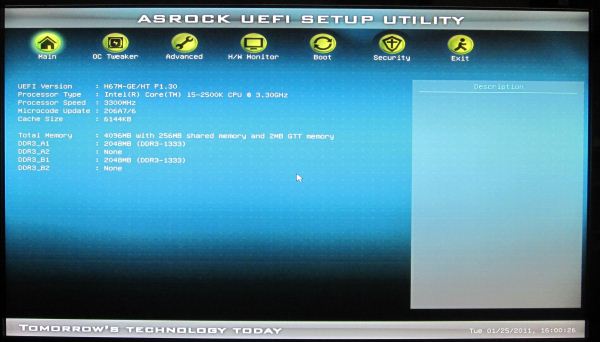
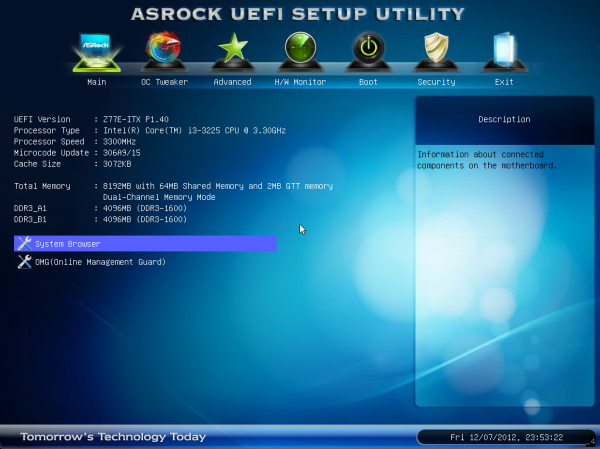
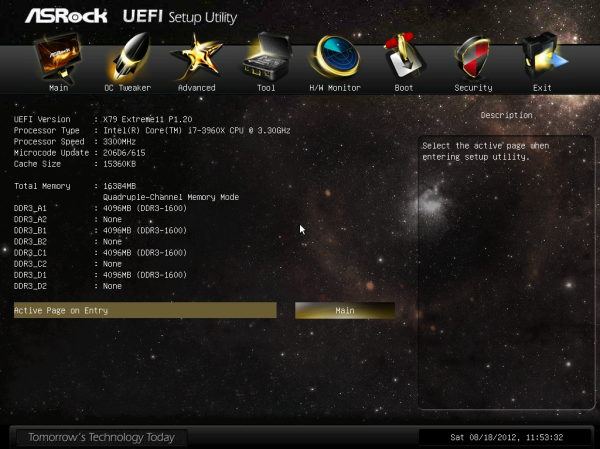
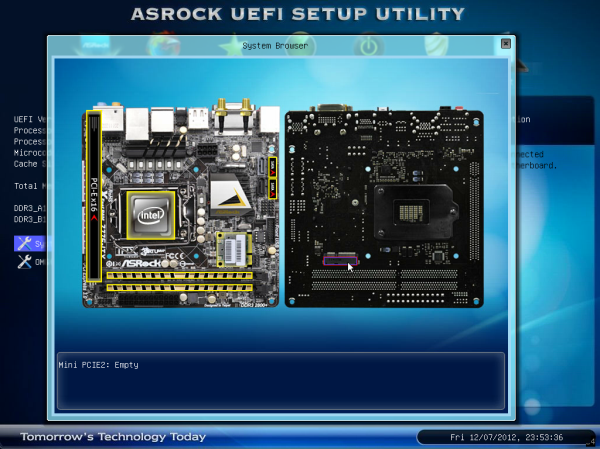
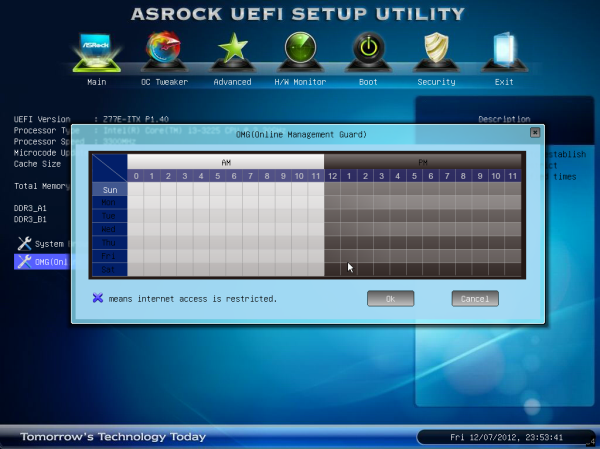
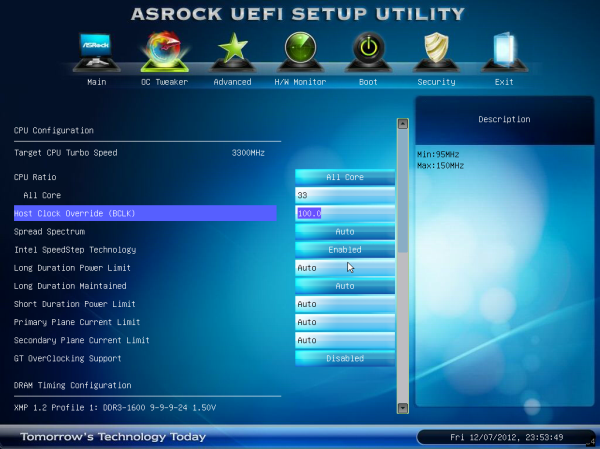
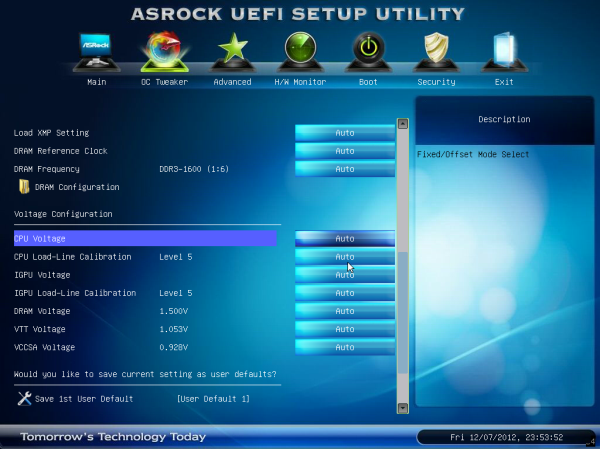
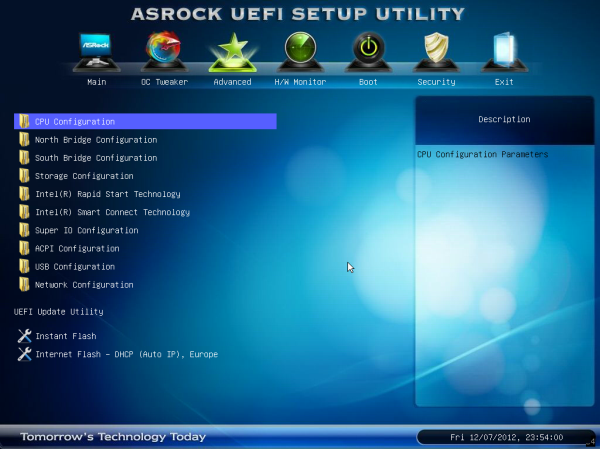
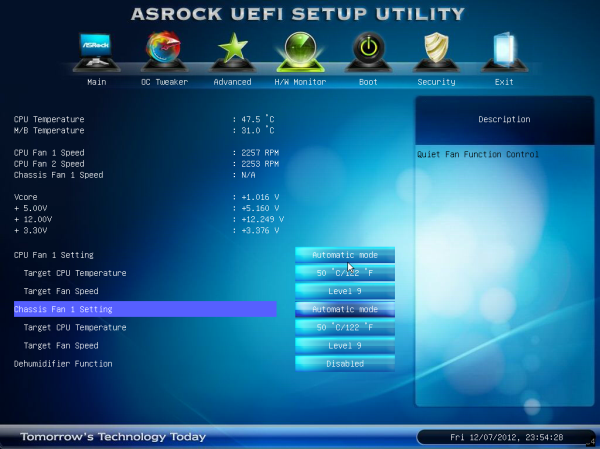














54 Comments
View All Comments
mike_b - Monday, December 31, 2012 - link
Interesting article, but I have to ask why would someone spend more for a Z77 chipset when using 'just' an i3? Surely a much cheaper H61 chipset could do the job admirably, and at much lower cost.Z77 makes sense if you're overclocking, which is excluded from this test...
IanCutress - Monday, December 31, 2012 - link
H61 has no chipset USB 3.0, no chipset SATA 6 Gbps, and you are limited to PCIe 2.0. H61 is also technically limited to one single sided DIMM per channel, and no SATA RAID. There's also SRT to consider, that would be advantageous with the ASRock and the mSATA on the rear.Ian
mike_b - Monday, December 31, 2012 - link
It might make an interesting comparison to see what net advantage is gained with the added features of the Z77 chipset compared with the H61. If budgets are limited the ~100 dollar cost difference between the Z77 and H61 mainboards makes a big difference; that money saved could be put into something which makes more of a performance difference (SSD rather than HDD for example).Anandtech is one of the best tech sites around, you guys do a great job. I do sometimes see though an emphasis on more expensive products when in terms of real-world performance you could get almost the same thing at a much cheaper price. Might be worth mentioning somewhere.
Not least because with yet another new socket coming with Haswell all these 1155 boards will be seen as out of date soon anyway.
IanCutress - Monday, December 31, 2012 - link
Once we get into the swing with Haswell, we will hopefully covering the whole spectrum. Though it is worth noting that motherboard manufacturers, want to put their best foot forward, and would prefer their halo/channel boards get covered before their OEM / low end offerings. Hence this is why you rarely see many mainstream reviews that are not from forums dedicated to the market segment and users testing their own equipment. We are hoping to rectify the balance in due course. If there are any specific products you might want us to test or examine, drop me an email and I'll see what I can put in my schedule (as full as it is[!]) :)Ian
StormyParis - Monday, December 31, 2012 - link
This is a major issue, not limited to motherboards: whenever I'm looking for something middle of the road or outright cheap, I can't find reviews.These Z77 MBs are a nice example: even though I'm recommending/building PCs regularly, most of them mini-ITX, I never came across a use case for Z77. Nobody apart from teens that still have something to prove overclocks anymore. People who want to do multi-GPU get a big case, and a big board. Are we supposed the extrapolate that the makers of good Z77 boards also make good H77 and H61 boards ?
I understand you've got to make do with what you're given by the OEMs. And that reviews was very good, as usual. Pity it is irrelevant ?
Tech-Curious - Monday, December 31, 2012 - link
That's an interesting observation. I have to say, I never noticed a significant lack of coverage for low-to-mid-range components (either in general or on Anandtech in particular), until this Fall, when I was in the market for a lower end motherboard.I guess I just always gravitated to higher end mobos before. Or maybe the coverage for such products was more comprehensive years ago. My memory's foggy, so it's hard to say.
In any case, motherboards appear to be the exception. If anything, I think the internet has generally grown more bullish on low-to-mid-range CPUs and GPUs in recent years (probably, in part, as a result of the stagnating console situation, which results in stagnating system requirements for games).
But all of that rambling aside, yeah. It'd be nice to see more diverse motherboard analysis. When I bought a b75 a couple of months ago, I literally couldn't find a review for that chipset. It wasn't a big deal; it's not like b75's features are any great mystery, after all -- but it is a little nettlesome to trip over sixty bajillion z77 reviews when there's nary peep about any other chipset.
In other news, Ian's review is a good one -- and given that I've been a faithful user of Asus motherboards for the last 15 years, it's nice to see them take home the prize. :)
Etern205 - Saturday, January 5, 2013 - link
My guess would be, why review a cheap board when majority of the readers here won't even bother buying it?And as for Asus boards, I've heard, they do something called based-line features. This means all boards from the bottom of the range to the top (Intel B75-Z77) will have the same base-line features, other features are just added like BT, WiFi, extra lan, etc.
Tech-Curious - Wednesday, January 9, 2013 - link
Yes, I think the issue is that (at least with respect to Intel chipsets) low-end motherboards don't support overclocking. So they're both less interesting to review (fewer measurable differences in performance among different models), and they're less appealing to the presumed audience of sites like Anandtech.Still, the B75 is a perfectly good chipset. If you aren't heavily invested in overclocking, z77's advantages are likely wasted on you. Personally, I'm well beyond my overclocking days; I just don't have the time or the patience to go through the almost endless tuning process anymore. (Even if you find a stable OC at the outset, it can become unstable later, and/or a given application might expose instability that stress testing didn't, weeks or even months down the road).
jonjonjonj - Friday, January 4, 2013 - link
just cause you don't overclock doesn't mean other people don't. why wouldn't you? because you want to get the fastest cpu that you can afford means you have something to prove? some people are just idiots.Zap - Monday, December 31, 2012 - link
But there isn't a $100 difference between H61 and Z77. There is a cheaper Gigabyte Z77 ITX board that's only around $60 more than the cheapest H61 ITX board, and it was even on sale recently for another $13 off making it less than $50 difference.Alternately one can go the H77 ITX route and get all the Z77 goodies except for overclocking, for around $30 less than the cheapest Z77 ITX. I think $30 more than H61 is reasonable for those extra features, plus guaranteed out-of-the-box BIOS support for Ivy Bridge.
I do agree with your (mike_b) first post regarding the choice of CPU used. Ian Cutress, didn't you have a spare K CPU laying around? There are so many people building overclocked ITX rigs these days. I did in a Silverstone SG05 with low profile air cooler to hit 4.2GHz. Plenty of others use the Bitfenix Prodigy and liquid cooling to hit clocks normally reserved for ATX rigs. Another review site (Tweaktown) tested overclocking on Z77 ITX boards and the ASRock hit near 4.8GHz. THAT'S what I want to see.
Of course this AnandTech roundup has some very useful information too, such as DPC latency tests and POST times. Keep up the good work there! But please, know your audience. Next time if the board is supposed to be overclockable, test that feature.
Maybe there can be a companion article about overclocking and heatsink clearance? Would be a shame to not overclock this nice collection of Z77 ITX boards.